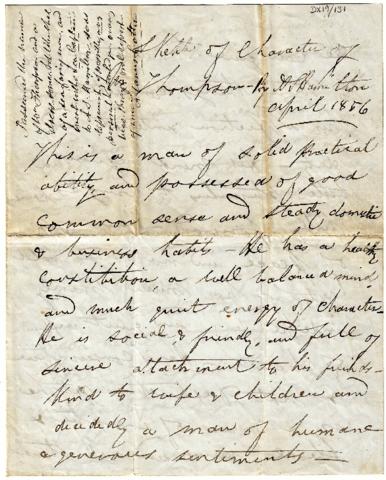Identity area
Reference code
Title
Date(s)
- 1856 (Creation)
Level of description
Item
Extent and medium
1 doc
Context area
Name of creator
Biographical history
Francis Cotton (1801-1883), Quaker and settler, was born on 6 October 1801 in London, where he had some early education before attending Ackworth School. After an apprenticeship to a builder, he set up his own business. When 19 he was disowned for marrying outside the Society of Friends, Anna Maria Tilney, a former Friend from Kelvedon, Essex. Rheumatic fever, London fogs and visions of brighter prospects for a growing family induced him to sail in 1828 for New South Wales in the Mary with an old friend, Dr George Story. The voyage was prolonged by the loss of a mast, and when the ship put in to Hobart Town the party decided to remain. For more information see http://adb.anu.edu.au/biography/cotton-francis-1924
Name of creator
Biographical history
Archibald Sillars Hamilton, known professionally as 'AS', became one of the most famous phrenologists in colonial Australia. Born in or before 1819 in Ayrshire, Scotland, he grew up as phrenology reached a frenzy of popularity in his native country. His father, Edward Hamilton, was a muslin manufacturer, but it was the influence of his mother, the popular phrenologist Agnes Sillars Hamilton, that determined his future livelihood. Hamilton arrived in Launceston in November 1854, and over the next 30 years lectured and gave private readings across Tasmania, Victoria, New South Wales, Queensland and both of New Zealand’s islands. In 1854, a private customer of Hamilton’s could opt for either a description of their character with advice (3 shillings, 6 pence), a written sketch of character (5 shillings), or a detailed character reading with a phrenological chart (10 shillings). Hamilton was given the head of Ned Kelly after his death and he published an account of the skull's phrenology. Phrenologists believed that the exterior of the skull directly reflected the surface of the brain, which itself comprised a multitude of organs responsible for functions ranging from love of children to religiosity, concentration, and social sympathy. Hamilton was charged in 1860 in Maitland with inciting to exhume corpses from a burial ground. His target in that case was the skull of the Aboriginal man Jim Crow, executed a few months earlier. Hamilton’s collection of human remains was a powerful drawcard to his lectures. By the time of his death, he had amassed some 55 skulls or parts thereof – about 30 Aboriginal, four Maori, one 'Hindoo', one Chinese, and the rest European. He sourced them not only through grave-robbing, but also through gifts and trades within the networks he forged in each new town. Hamilton died in Redfern, Sydney, in 1884
See : https://www.portrait.gov.au//magazines/51/getting-a-head/
Immediate source of acquisition or transfer
Content and structure area
Scope and content
Phrenology report dated 1856 by Archibald S. Hamilton on Francis Cotton who assumed the name William Thompson and the dress of a 'seafaring man' so as to prevent if possible, any personal knowledge or bias through an oral report.'
Appraisal, destruction and scheduling
Accruals
System of arrangement
Conditions of access and use area
Conditions governing access
Conditions governing reproduction
This material is made available for personal research and study purposes under the University of Tasmania Standard Copyright Licence. For any further use permission should be obtained from the copyright owners. For assistance please contact Special.Collections@utas.edu.au
Language of material
Script of material
Language and script notes
Physical characteristics and technical requirements
Finding aids
Existence and location of originals
Existence and location of copies
Related units of description
Alternative identifier(s)
Access points
Subject access points
Place access points
Name access points
Genre access points
Description identifier
Institution identifier
Rules and/or conventions used
Status
Level of detail
Dates of creation revision deletion
Language(s)
Script(s)
Sources
Digital object metadata
Latitude
Longitude
Media type
Text
Mime-type
application/pdf


